In this article, you will learn what is Piston Pin? Its construction, working, design methods, general requirements, and strengths are explained with diagrams.
In addition, you can also download the PDF file of this article at the end.
What is Piston Pin or Gudgeon Pin?
In an internal combustion engine, the piston pin helps to connect the piston to the connecting rod and provides bearing support for the connecting rod to pivot when the piston needs to move. Or in simple words, the piston pin is a connecting link between the piston and the connecting rod.
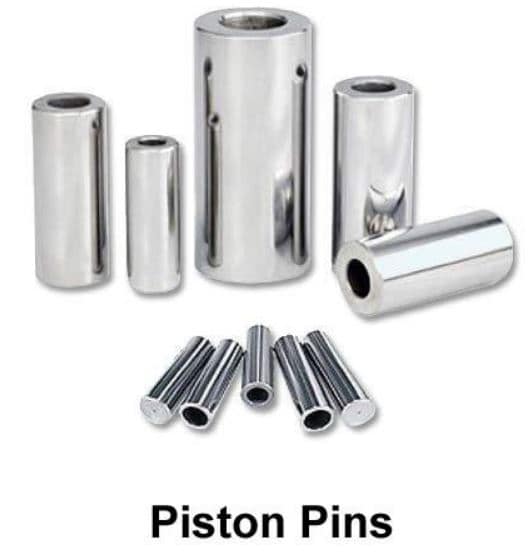
In most engine arrangements, including steam-powered engines, large stationary and/or marine engines, this pin is located in a sliding crosshead that usually connects to the piston via a rod.
This pin is a forged small hollow rod usually made of high-strength steel alloy. The pin design is challenging, especially in the case of small, high-revving automotive engines. Let’s know the working of the piston pin.
Construction
It looks almost the same as a simple cylindrical shaft, which can be solid or hollow. The ends of this pin have a chamfer. This pin is kept in the piston by a circular saw, while from the middle it is surrounded by the small-bore end of the connecting rod.
Generally, it is made of specially hardened steel and can withstand shear loads due to force transfer from the piston to the connecting rod. Well, it has very fine diameter tolerances for a perfect fit in the piston bore.
Read Also: What is Crankshaft and How Does It Work?
Working
The piston pin (gudgeon pin) provides a smooth joint between the engine’s connecting rod and the piston. The pin may be subject to high loads in alternating demands due to the oscillating motion of the piston, gas interaction, and inertial forces.
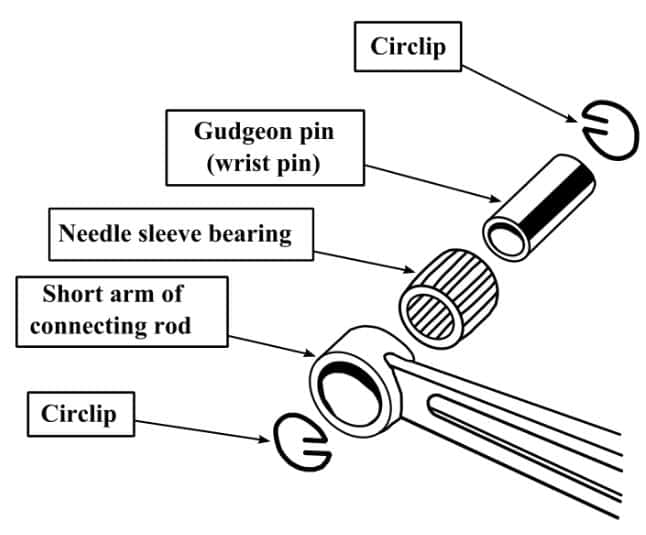
In a gasoline engine, the rotary motion of the connecting rod relative to the piston must be balanced in the bearing locations of the pin, the pin boss, and the small end bore. Due to the small relative speed, the lubrication condition here is poor.
In gasoline-powered engines with medium-specific output, the pin is fixed with shrinkage stress in the small end bore. This allows savings due to the elimination of the pin circle and the bushing being bored at the short end.
Whereas in diesel engines, this pin “floats” in the smaller end bore. It needs to be secured with a piston pin circlip to eliminate sideways motion in the piston pin.
Types of Piston Pin
These are mainly designed in three configurations:
- Stationary
- Semi-floating
- Full-floating
#1 Stationary Type
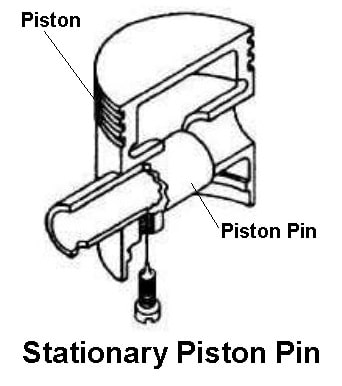
The stationary pin is secured to the piston on the boss, and the connecting rod slides on the pin. Since all movement is made by the connecting rod, can occur uneven wear on the contact surfaces in this type of installation. Due to this, the use of this type of pin is not typical in diesel engines.
#2 Semi-floating Type
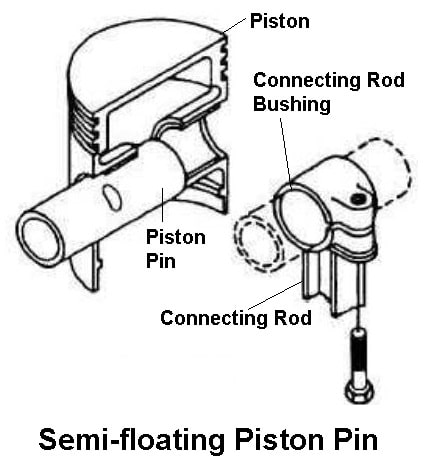
In this type, the pin is usually fixed relative to the piston by an interference fit with the help of a journal. These pins are secured to the middle of the connecting rod and the short end bearing of the connecting rod thus acts as a stand-alone bearing. In this pin, only the short end bearing is required for the bearing surface.
If this is required, it is provided either by electroplating the short end journal with a suitable metal, or a sleeve bearing into the short end eye, in which Interference fits with the orifice of small ends. During an overhaul, it is usually possible to replace this bearing sleeve if it is badly worn out.
In the reverse design, when the pin is fixed to the connecting rod instead of the piston. It is instead executed using an interference fit with the short end I, so the pin in the piston acts as a journal bearing.
These are complicated to manufacture and service because the two bearing surfaces or insert sleeves confuse the design. Also, the pin must be set properly so that the short-end eye is central.
#3 Full-floating Type
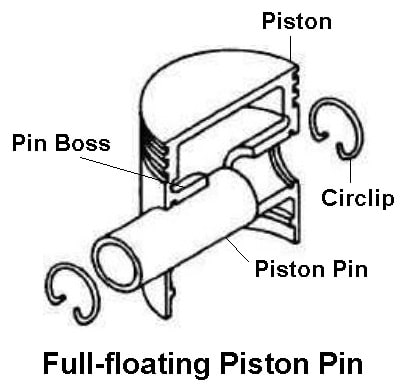
In this design, a bearing surface is made between both the short end eye and the piston pin and the journal in the piston. These types of pins are usually secured with circlips. In this case, there is no interference fit used and the pin is completely floated on the bearing surfaces.
The average speed of each three bearings is split and the load is transferred to a bearing that is typically around three times the length of a semi-floating design with an interference fit with the piston. Of the three types of pins, the most common is the full-floating pin.
Read Also: What Does The Camshaft Do? Parts and Functions [PDF]
What is Piston Pin Offset?
This is the piston wrist pin which is slightly offset from one side of the piston i.e. should not be in the center of the piston. To understand why this happens, let’s consider these two cases:
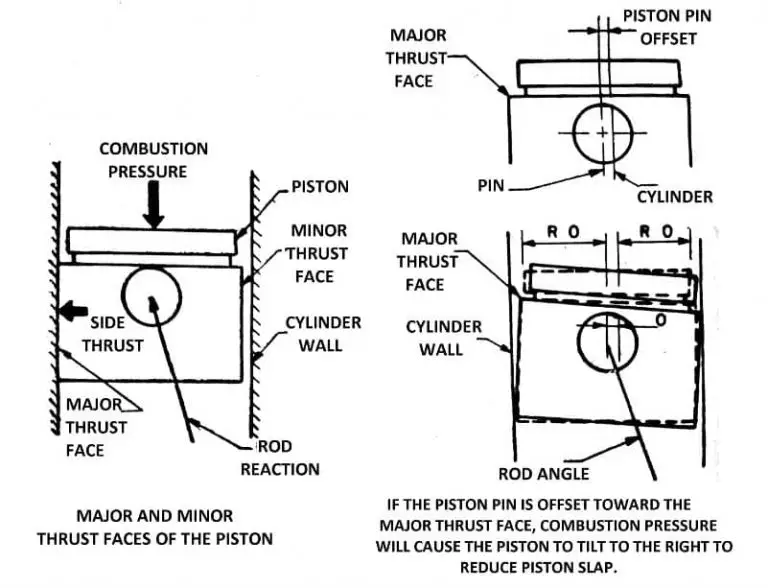
- When the pin is in the center of the piston, now that the piston reaches TDC or BDC. In this position, the rod moves straight up and down, placing a heavy load on the rod. The crank has to move past TDC or BDC to make the piston move again. This rods provides both a lot of power and RPM from the engine.
- With an offset pin, the piston wrist pin is slightly offset to one side of the piston so the rod doesn’t move straight up and down when the piston is at TDC or BDC. This allows the crank to rotate with less resistance giving the engine more power and speed.
Having an offset pin relieves tension when the rod reaches the TDC or BDC. The rod doesn’t have to hit the piston up and then down. The rod travels more in an arc.
Requirements of a Piston Pin
The pin must meet the following requirements:
- The pin must have sufficient strength and flexibility to withstand the load without damage.
- It requires high surface hardness to achieve favorable wear behavior.
- These pins must achieve high surface quality and size accuracy for optimum fit with their sliding parts, piston and connecting rod.
- To keep the inertia forces to a minimum, these pins must have a low weight,
- The rigidity of the pin should match the design of the piston, so as to avoid overloading the piston.
- Despite from above, the pin construction should be as simple and thus economical as possible.
Strength of an Piston Pin
Under the impact of gas and inertial forces when working, pressure and tension loads act on the surface of the pin. Therefore the distribution of which is defined by the deformation of the piston pin bores, piston pins, and short end bore, which is caused by forces.
As a result of the distribution of the pressure, the pin may be subject to high bending, elliptical, and shear forces. Added to this is a torsional load caused by the connecting rod tilting motion.
However, it is neglected due to the limited proportion of the total load. On the other hand, the requirement is that the pin is as rigid and light as possible.
Wrapping It Up
As I already said, the piston pin is a small part used to connect the piston to the connecting rod in an internal combustion engine and provides a bearing to pivot the connecting rod when the piston is moving.
So for now, I hope that you have learned about this article. If you have any questions or doubts about this article, feel free to ask in the comments. If you got this article helpful, please share it with your friends.
Want free PDFs in your inbox? Then subscribe to our newsletter.
Download PDF of this article:
You might like to read more in our blog:
- What are the different types of Piston Rings? Their Functions [PDF]
- What is the function of a Distributor in a Ignition System?
- How univerasl joint works in a car? Types, Parts, & Advantages
External Links:
- https://en.wikipedia.org/wiki/Gudgeon_pin
- https://link.springer.com/chapter/
I have learnt more from your website
I’m glad it was helpful for you. Keep visiting 😉
This is good I have learned more from u people
I’m glad it was helpful for you. Keep visiting.